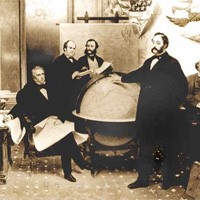The 1867 purchase of Alaska by the United States marked a pivotal moment in history, raising the question: Why Did The Russians Sell Alaska? This seemingly inexplicable decision stemmed from a confluence of factors, ranging from economic pressures to geopolitical considerations. Russia’s ambitions in North America, ignited by Czar Peter the Great’s exploration efforts in 1725, ultimately waned, leading to the territory’s sale.
Russia initially saw Alaska as a valuable asset, rich in natural resources and offering a foothold on the Pacific coast of North America. However, maintaining this vast and sparsely populated territory proved challenging. The costs associated with administration, defense, and development outweighed the economic benefits derived from fur trade and other ventures.
 altSigning of the Alaska Treaty in 1867, formally transferring ownership of Alaska from Russia to the United States.
altSigning of the Alaska Treaty in 1867, formally transferring ownership of Alaska from Russia to the United States.
The Crimean War (1853-1856) further strained Russia’s finances and weakened its position on the world stage. Facing mounting debts and the threat of British expansion in the Pacific, Russia deemed Alaska a liability rather than an asset. Selling the territory to the United States presented a strategic opportunity to recoup some financial losses and potentially thwart British ambitions in the region.
The United States, meanwhile, saw potential in Alaska’s vast resources and strategic location. Secretary of State William Seward championed the purchase, recognizing its long-term significance for American expansion and influence in the Pacific. Despite initial skepticism and criticism, often referred to as “Seward’s Folly,” the deal was finalized for $7.2 million on March 30, 1867.
The discovery of gold in the Yukon in 1896, decades after the purchase, validated Seward’s vision. Alaska became a gateway to the Klondike Gold Rush, attracting a surge of prospectors and transforming the territory’s economic landscape. The strategic importance of Alaska became even more apparent during World War II, solidifying its value to the United States.
Beyond economic considerations, Russia’s decision to sell Alaska was influenced by the desire to consolidate its power in other regions and avoid potential conflicts with Great Britain. The sale allowed Russia to focus on domestic challenges and strengthen its position in Europe and Asia.
In conclusion, the sale of Alaska was a complex decision driven by a variety of factors. Russia’s economic difficulties, geopolitical concerns, and the desire to avoid conflict with Great Britain ultimately led to the decision to sell the territory to the United States. While initially viewed with skepticism by some, the purchase proved to be a shrewd investment for the United States, granting access to valuable resources and a strategically important location in the Pacific. The transaction forever altered the geopolitical landscape of North America and the Pacific Rim.
